AMD FX-8320E CPU Review: The Other 95W Vishera
by Ian Cutress on January 13, 2015 10:00 AM ESTF1 2013
First up is F1 2013 by Codemasters. I am a big Formula 1 fan in my spare time, and nothing makes me happier than carving up the field in a Caterham, waving to the Red Bulls as I drive by (because I play on easy and take shortcuts). F1 2013 uses the EGO Engine, and like other Codemasters games ends up being very playable on old hardware quite easily. In order to beef up the benchmark a bit, we devised the following scenario for the benchmark mode: one lap of Spa-Francorchamps in the heavy wet, the benchmark follows Jenson Button in the McLaren who starts on the grid in 22nd place, with the field made up of 11 Williams cars, 5 Marussia and 5 Caterham in that order. This puts emphasis on the CPU to handle the AI in the wet, and allows for a good amount of overtaking during the automated benchmark. We test at 1920x1080 on Ultra graphical settings.
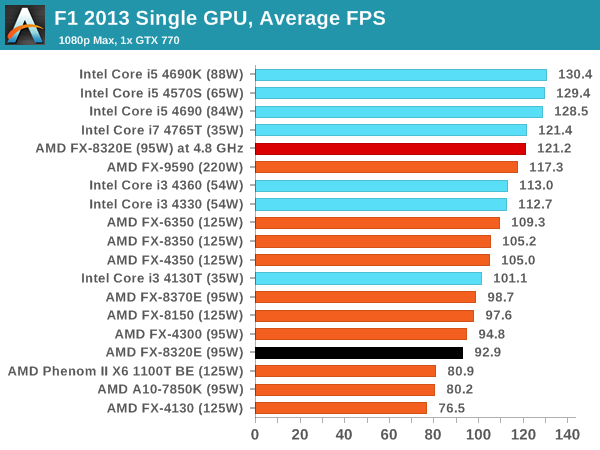
In both single and dual GPU cases, the stock performance of the FX-8320E falls behind the i3 CPUs by a 10-20 FPS margin, perhaps being noticeable on 120 Hz monitors. The minimum FPS on a single GPU still retains above 60 FPS, which is a plus.
Bioshock Infinite
Bioshock Infinite was Zero Punctuation’s Game of the Year for 2013, uses the Unreal Engine 3, and is designed to scale with both cores and graphical prowess. We test the benchmark using the Adrenaline benchmark tool and the Xtreme (1920x1080, Maximum) performance setting, noting down the average frame rates and the minimum frame rates.
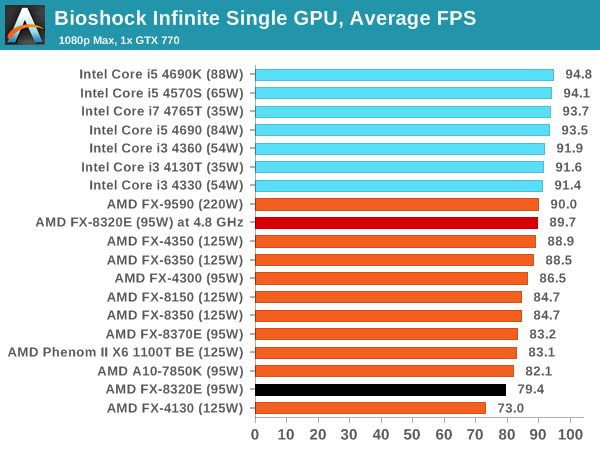
While average frame rates almost appear to be CPU agnostic, there is a clear AMD/Intel split here. More interesting is the minimum FPS results which seem to rely on IPC.
Tomb Raider
The next benchmark in our test is Tomb Raider. Tomb Raider is an AMD optimized game, lauded for its use of TressFX creating dynamic hair to increase the immersion in game. Tomb Raider uses a modified version of the Crystal Engine, and enjoys raw horsepower. We test the benchmark using the Adrenaline benchmark tool and the Xtreme (1920x1080, Maximum) performance setting, noting down the average frame rates and the minimum frame rates.
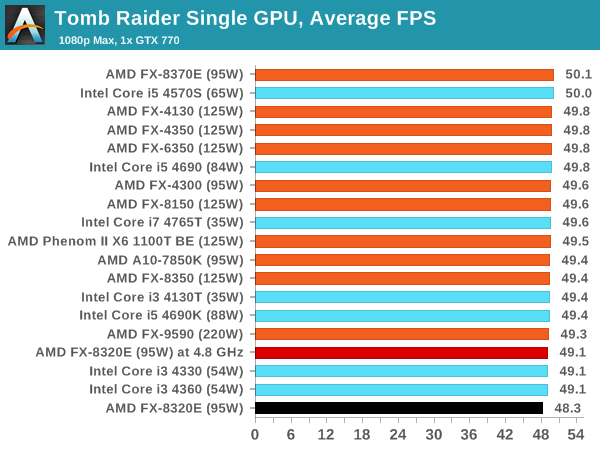
Tomb Raider still comes across as purely CPU agnostic.
Sleeping Dogs
Sleeping Dogs is a benchmarking wet dream – a highly complex benchmark that can bring the toughest setup and high resolutions down into single figures. Having an extreme SSAO setting can do that, but at the right settings Sleeping Dogs is highly playable and enjoyable. We run the basic benchmark program laid out in the Adrenaline benchmark tool, and the Xtreme (1920x1080, Maximum) performance setting, noting down the average frame rates and the minimum frame rates.
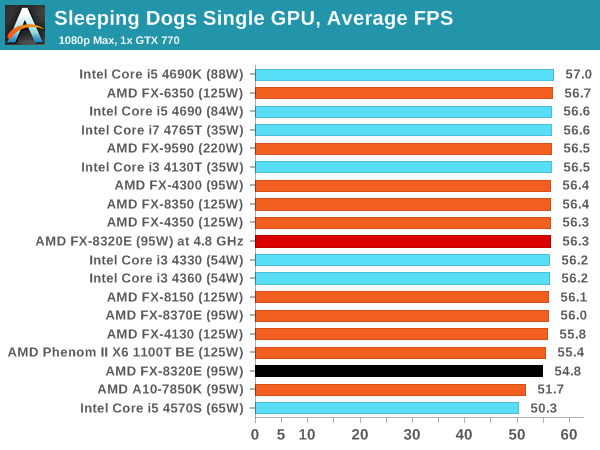
Single GPU usage puts the 8320E in the ballpark, but moving to dual GPUs sees an uplift in terms of the i5 CPUs for high refresh rate screens, albeit with the extra cost associated.
Battlefield 4
The EA/DICE series that has taken countless hours of my life away is back for another iteration, using the Frostbite 3 engine. AMD is also piling its resources into BF4 with the new Mantle API for developers, designed to cut the time required for the CPU to dispatch commands to the graphical sub-system. For our test we use the in-game benchmarking tools and record the frame time for the first ~70 seconds of the Tashgar single player mission, which is an on-rails generation of and rendering of objects and textures. We test at 1920x1080 at Ultra settings.
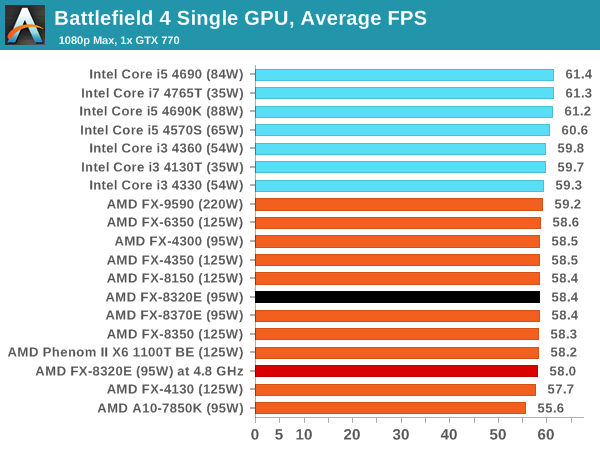
Single GPU shows little difference (despite a clear AMD/Intel separation line), but in dual GPU mode an i3 will make a 17 FPS rise, moving to 27 FPS with the i5 and more relevant to high refresh displays.















92 Comments
View All Comments
jabber - Friday, January 16, 2015 - link
And with the labour charges etc. all included you could well have just bought a job lot of new Dell Dimensions.Plus decent AM3 chips are tres expensive now.
phoenix_rizzen - Friday, January 16, 2015 - link
Actually, our hardware costs are decreasing slightly each year while the hardware it buys is increasing. Our current desktops are around $150 CDN including motherboard with Radeon graphics onboard, Athlon-II x4 CPU, 2 GB of RAM. We run diskless Linux, so no harddrive, no floppy drive, no optical drive; the only moving parts are the CPU, PSU, and case fans (and sometimes we even remove the case fan).Our original build with nVidia 6100 graphics onboard, 512 MB of RAM, and a Sempron CPU was over $200 CDN 7-odd years ago.
Buying the CPUs in bulk for upgrades was less than half the cost of a new system. Buying RAM upgrades was much less than half the cost of a new system. And a single tech working for a full day could upgrade an entire lab of 30 stations with some time to spare for testing ... for less than the cost of a single new system.
We've been doing this for just over 12 years now. We know which is less expensive for us, and it's not buying name brand computers with Intel CPUs and chipsets. Everytime we put a bid out for systems, the Intel systems are more expensive without being a whole lot more powerful, and they require discrete GPUs, whereas the AMD systems include graphics support on the motherboard (Intel 3D has improved over the years, but still doesn't hold a candle to nVidia or AMD).
ddriver - Wednesday, January 14, 2015 - link
Why would you go for an AMD build? I am not a big fan of Intel's past practices, and as much as I sympathize with AMD their products are simply way too weak, their performance per watt ratio is so low the lower hardware price doesn't really matter, you still end up paying more for it when you account for the electricity bills.Besides, for an office machine, a 5W ARM board costing 35$ suffices.
The only reason I can think of buying AMD is in case you want to burn some money to keep AMD afloat for the sake of not leaving intel without competition, not that AMD is much of a competitor anyway... More like a perpetually crippled "competitor" existing solely for the purpose of not running unopposed.
phoenix_rizzen - Thursday, January 15, 2015 - link
See my post just above yours (posted after yours in time).ddriver - Saturday, January 17, 2015 - link
So the people who benefit from AMD are those who don't have enough money, so they can end up spending more for less over time? Doesn't sound like a good deal...phoenix_rizzen - Monday, January 19, 2015 - link
And I guess black is white and down is up in your world?Jinx50 - Sunday, January 25, 2015 - link
Ironically in contrast to all the misinformation spewed "above and below" I still play Crysis 3 on ultra with a overclocked 1090T @ 3.8GHz and a HD 6970.I'm still waiting for the unplayable game to arrive "to give me a reason to upgrade" meanwhile I have to ask, how many Intel chips and boards have you all burned cash on in the last 5 years?
I'm not hating on Intel just stating facts "in my instance in regards of the bang for the buck factor", and I will probably snag an FX 8xxxx when this rig finally hits the medium settings wall.
AMD is not a processor for those who don't have the money "on the contrary". It's the processor for those who want to KEEP THEIR MONEY. ROFL I could dump money on an Intel but do I want to ride that roller coaster NOPE..
Oxford Guy - Thursday, April 2, 2015 - link
The minimum frame rates in that Bioshock Infinite chart are worrisome.stefstef - Wednesday, January 21, 2015 - link
nope. intel just has the better processor portfolio. this is not because amd cpus are so bad, but intel has the advantage of a much lower production process (22nm instead of 32nm). they are technically ahead in every sector: design, process and manufacturing. nonetheless amd makes sense as intel charges for the premium quite some good money. the usual jobs might be done by a amd as well as an intel.TheinsanegamerN - Wednesday, January 14, 2015 - link
I wouldnt go so far as to say that AMD wont give you a good experience. I traded, on a bet, my motherboard and cpu with my other pc gaming friend, and went from an i5 3570k to aq fx 6300. know how much of a difference there is? nothing. both get 60fps in everything at 1200p with my 770. i will say, if i have multiple game servers running in the background, the fx does not slow down nearly as much as the i5 ever did, even though hypothetically the i5 was more powerful, it couldnt multitask as well.and with the new consoles both coming with 8 core cpus, i think AMD chips will still work well, at least for the forseeable future.